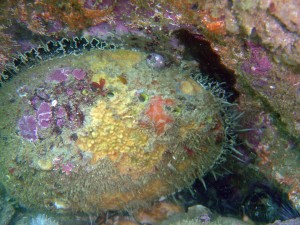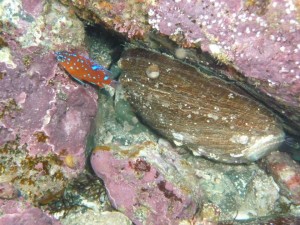By Garry Brown, Executive Director / Orange County Coastkeeper
Some of us remember the days when you could simply walk out at low tide and pluck an abalone off the rocks. It seemed that every bar in Newport Beach had an abalone shell for an ash tray, and I recall seeing decorative walls made of abalone shells. This species, which was once plentiful, is now nearly impossible to find.
 According to Dave Witting, a fish biologist for the National Oceanic and Atmospheric Administration, “abalone have been historically, culturally and economically important as a food source for people going back 10,000 years, and more recently, as a recreational and commercial industry that created a connection to the ocean for people.”
According to Dave Witting, a fish biologist for the National Oceanic and Atmospheric Administration, “abalone have been historically, culturally and economically important as a food source for people going back 10,000 years, and more recently, as a recreational and commercial industry that created a connection to the ocean for people.”
Abalone was as much a part of the 1950s and 1960s beach scene as were long boards, woodies and the Beach Boys.
Historically, five species of abalone (red, pink, green, black, and white) were abundant in Southern California’s coastal waters. Stock collapse due to fishing pressure, disease, predation, and environmental factors, including water quality, led to the closure of all abalone fisheries in Southern and Central California in 1997. Abalone populations have not since recovered and today only Northern California’s red abalone sport fishery remains.
Coastkeeper’s Green Abalone Restoration Project has the goal of restoring green abalone in Southern California through a multiple year project that will create a self-sustaining population in Orange County. This is one part of a larger coalition of partners working to restore populations of this species along the Southern California coast in coordination with the National Marine Fisheries Service (NMFS), National Oceanic and Atmospheric Administration (NOAA), and the California Department of Fish and Wildlife (DFW).
In 2012, Coastkeeper, and project collaborators, collected genetic samples from wild green abalone along mainland Southern California and the Channel Islands to determine the degree of difference between individuals found in different areas of the region.
Preliminary results show that wild green abalones are related, thus making a regional restoration effort more effective.
Coastkeeper has already begun the next step towards recovery for abalone by implementing a citizen-science monitoring program for Orange County this year.
Abalones are a key component of the overall health and function of the shallow rocky reef ecosystems in which they are found.
“Bringing abalone back will help restore the natural function of our coastal ecosystems,” states Amanda Bird, marine restoration coordinator for Coastkeeper. “Abalones are important herbivores in the marine food web, and are a food source for lobsters, Sheephead, even sea otters.”
Bird explains that abalones compete for food and space with sea urchins, which help to control urchin populations. Urchins, if left unchecked, contribute to the destruction of kelp forests as they feed on kelp holdfasts.
Now is an ideal time to start the abalone restoration process along our coast because conditions are just right. Kelp restoration efforts throughout the early 2000s were very successful, and the health and growth of giant kelp forests are an indicator that we are in an ideal climate to outplant abalone.
“There was very little evidence that abalones are recovering. In the last decade, we have experienced a shift in oceanographic conditions, which occurs every decade, and current conditions have shown greater kelp growth, and a greater abundance of abalone recovering,” states Witting. “This all sets the stage for active restoration, and if we do enter another period with less than ideal conditions for the abalone, there will be more of them to make it through.”





Oh Garry, its ok too mention the rock star employee you dismissed that really headed and completed the giant kelp program, and now the So Ca abalone restoration project. Dropped like a golden egg in your happy fundraising lap. Marine Biologist, Founder, Executive Director of “Get Inspired”, Captain Nancy Caruso, is the number one leader here. Nancy is on the water, in the water and in many classrooms growing abalone and white seabass. Its to bad these NGO’s like Coastkeeper and Surfrider can’t share the real hard work of others paving the way that put donations in their pockets.
Telling the whole truth isn’t a bad thing Mr. Coastkeeper, it makes you a bigger person and your organization. Thank you Captain Caruso for getting this project on the table, without you it wouldn’t of happened.